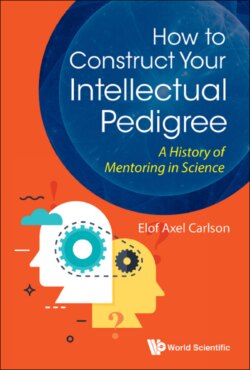Читать книгу How to Construct Your Intellectual Pedigree - Elof Axel Carlson - Страница 18
На сайте Литреса книга снята с продажи.
11Representing Inputs to My Academic Life
ОглавлениеThe circular figure that follows represents my life from the perspective of inputs. We know many of the major influences on our lives. Many of them are shared by others. Each of us is unique in the environmental sense that we live independent lives (even conjoined twins). The circle begins at noon and goes clockwise. For convenience I have listed these in more detail in the legend to this circle of inputs. I have listed the environmental factors but realize there are also genetic factors that may filter or distort our reception and interpretation of environmental influences. Those are harder to designate because our knowledge of the genetic composition and regulation of the nervous system is still inadequate compared to what we know about environmental influences on our lives. Muller used the phrase “life the lucky” to represent the diversity both genetic and environmental influences in our lives. When we are born may determine if we experience wars and catastrophes. We have no control over who our biological parents are or if we are orphans or adopted and raised by parents unrelated to us biologically.
In my own life I have been heard by thousands of students because I preferred to teach large introductory courses with 100 to 600 students in a lecture hall. I presume this is also true for the thousands of persons who have read my various books and articles. But as people leave their institutions and work elsewhere or retire or die, they are rapidly forgotten. I used to ask my students to name as many Nobel laureates in the life sciences as they could, but few could name more than a dozen. My selection of inputs is thus biased because I do not remember who taught me each fact or idea I know or when I first came to know them.
I chose Muller as my second example because next to myself, I know more about his life than I do even of my siblings. I had the privilege to write his biography and I helped classify thousands of documents he left to the Lilly Library at Indiana University. Muller’s life is more adventurous than mine and he lived his adult life largely in a world at war or in economic collapse. His education reflects more of the nineteenth century than does mine. We both chose academic lives, but Muller’s was much more heavily involved in research and mine was more heavily involved in teaching and writing. We both had failed first marriages and very happy second marriages, but this is probably coincidence rather than a reflection of inputs into our personalities. We both had a Jewish ancestry on our mother’s side, but this too is probably coincidental. It is difficult to know what we can infer about upbringing from the inputs into our lives. But we shouldn’t minimize the power of ideas, personality, and skill that lead us to emulate those who have had positive influences on our lives.
By representing inputs and outputs as circular diagrams, I bring out the complexity of how our minds are shaped. There are dozens of biographies of scientists and it will be an interesting project to do a comparative study of inputs and outputs. They may reveal some common features and the time in which shared components emerged in these lives. I believe molecular and genetic insights into creativity and mental development will eventually be revealed in detail. I also believe that studies of inputs and outputs have much to offer scholars in the history, philosophy, and sociology of science.
